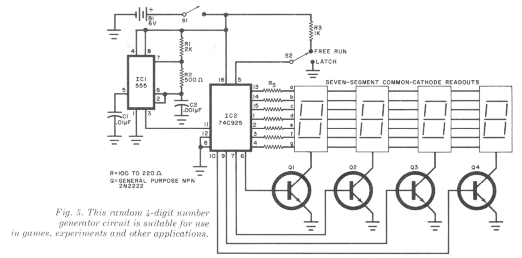
(Click this image for a larger version.)
Suitable for use in games, ESP experiments, and other applications, the random 4-digit number generator circuit illustrated in Fig. 5 was submitted by reader Micahel S. Pyska (Lewiston, NY). Requiring relatively few components, the design should be a good single evening's or weekend's project for the average hobbyist. The "heart" of Mike's design is a four-digit counter containing integral multiplexed 7-segment output drivers. In operation, a free-running pulse generator or "clock," IC1, drives the counter continuously. Since the instantaneous count in IC2's register is changing rapidly, it is essentially a random number. Depressing and releasing the latch switch, S2, permits this number to be displayed on the readouts.
Standard components and devices are specified for the project. The clock, IC1, is a familiar type 555 timer while the counter/driver, IC2, is National Semiconductor's MM74C925. The four readouts are 7-segment common-cathode types, with the driver transistors, Q1 through Q4, type 2N2222 general-purpose npn devices. All resistors are one-quarter or one-half watt types, with the series readout current limiters, Rs, 100 to 220 ohm units (the exact value is not critical). Power switch S1 is a spst toggle, slide, or rotary unit, while the latch switch, S2, is a spdt, spring return pushbutton or lever type. Finally, the power pack consists of three or four series-connected penlight or flashlight cells.
With neither parts arrangement nor wiring dress critical, the random number generator can be assembled using any standard construction technique from simple perfboard to a carefully designed PC card. If desired, it can be used as a two or three, rather than four, digit generator, and common-anode instead of common-cathode readouts can be used by adding a pair of hex inverters.
You can see a datasheet for the 74C925 (in Adobe Acrobat format) by clicking here.